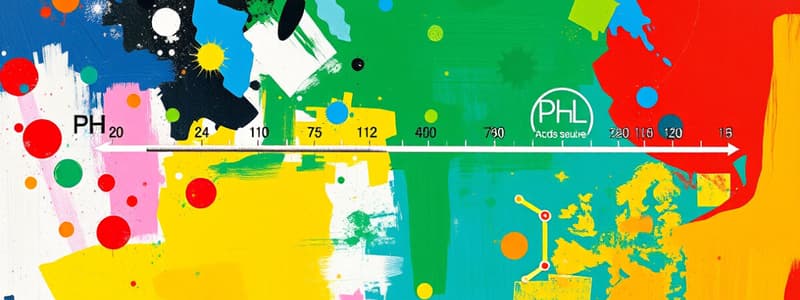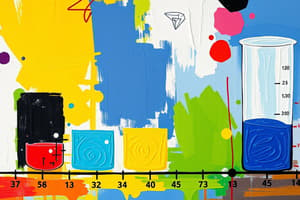Podcast
Questions and Answers
What does a pH value of 7 indicate about a solution?
What does a pH value of 7 indicate about a solution?
- It is a neutral solution. (correct)
- It is a strong base.
- It is a strong acid.
- It is a weak acid.
If red litmus paper remains red when dipped into a solution, what can be inferred about that solution?
If red litmus paper remains red when dipped into a solution, what can be inferred about that solution?
- The solution is a base.
- The solution is neutral.
- The solution is an acid. (correct)
- The solution has a pH of 7.
How much more acidic is a solution with a pH of 3 compared to a solution with a pH of 4?
How much more acidic is a solution with a pH of 3 compared to a solution with a pH of 4?
- 10 times more acidic.
- 1,000 times more acidic.
- 100 times more acidic. (correct)
- It is not more acidic.
Which of the following substances typically has a pH less than 7?
Which of the following substances typically has a pH less than 7?
What is true about the relationship between pH and H+ ion concentration?
What is true about the relationship between pH and H+ ion concentration?
What can be concluded if blue litmus paper turns red when placed in a solution?
What can be concluded if blue litmus paper turns red when placed in a solution?
Which of the following pH values indicates a strong base?
Which of the following pH values indicates a strong base?
When H+ ions are in higher concentration than OH- ions in a solution, what is the solution classified as?
When H+ ions are in higher concentration than OH- ions in a solution, what is the solution classified as?
What is the pH value of a strong acid?
What is the pH value of a strong acid?
What does a pH of 12 indicate about a solution's hydrogen ion concentration?
What does a pH of 12 indicate about a solution's hydrogen ion concentration?
Which of the following substances would most likely have a pH of 7?
Which of the following substances would most likely have a pH of 7?
If blue litmus paper remains blue when dipped into a solution, what can be inferred about that solution?
If blue litmus paper remains blue when dipped into a solution, what can be inferred about that solution?
How does the pH scale describe a neutral solution?
How does the pH scale describe a neutral solution?
Which of the following correctly identifies lemon juice based on its pH?
Which of the following correctly identifies lemon juice based on its pH?
What does the term 'ten-fold change' in relation to pH indicate?
What does the term 'ten-fold change' in relation to pH indicate?
Which solution is likely to have a pH lower than that of household ammonia?
Which solution is likely to have a pH lower than that of household ammonia?
What happens to red litmus paper dipped in a basic solution?
What happens to red litmus paper dipped in a basic solution?
What would be the likely pH range for a weak base?
What would be the likely pH range for a weak base?
Flashcards are hidden until you start studying
Study Notes
pH Scale Overview
- pH measures the acidity or basicity of a solution, with a range from 0 to 14.
- A pH below 7 indicates an acid, a pH of 7 indicates neutrality, and a pH above 7 indicates a base.
Classifying Acids and Bases
-
Acids:
- Blue litmus paper turns red.
- Contains more H+ ions than water.
- Examples include lemon juice (pH 4) and vinegar.
-
Bases:
- Red litmus paper does not change color.
- Contains less H+ ions than water.
- Includes drain cleaner and household ammonia.
-
Neutral Solutions:
- A pH of 7, indicating balance between H+ and OH- ions.
pH Scale Ranges
- Strong Acids: pH 0-3
- Weak Acids: pH 4-6
- Neutral: pH 7
- Weak Bases: pH 8-10
- Strong Bases: pH 11-14
Measuring pH Changes
- A one-unit change in pH represents a ten-fold change in H+ ion concentration.
- Example: A solution with pH 6 is 100 times more acidic than one with pH 7.
- Acidic comparison:
- A pH of 3 is ten times more acidic than a pH of 4.
- Basic comparison:
- A pH of 12 is 100,000 times more basic than a pH of 7.
Litmus Paper Testing
- Red litmus paper turns blue in the presence of a base.
- Blue litmus paper turns red in the presence of an acid.
- Litmus paper can help classify unknown solutions as acids, bases, or neutral based on color changes.
pH Scale Overview
- pH measures the acidity or basicity of a solution, with a range from 0 to 14.
- A pH below 7 indicates an acid, a pH of 7 indicates neutrality, and a pH above 7 indicates a base.
Classifying Acids and Bases
-
Acids:
- Blue litmus paper turns red.
- Contains more H+ ions than water.
- Examples include lemon juice (pH 4) and vinegar.
-
Bases:
- Red litmus paper does not change color.
- Contains less H+ ions than water.
- Includes drain cleaner and household ammonia.
-
Neutral Solutions:
- A pH of 7, indicating balance between H+ and OH- ions.
pH Scale Ranges
- Strong Acids: pH 0-3
- Weak Acids: pH 4-6
- Neutral: pH 7
- Weak Bases: pH 8-10
- Strong Bases: pH 11-14
Measuring pH Changes
- A one-unit change in pH represents a ten-fold change in H+ ion concentration.
- Example: A solution with pH 6 is 100 times more acidic than one with pH 7.
- Acidic comparison:
- A pH of 3 is ten times more acidic than a pH of 4.
- Basic comparison:
- A pH of 12 is 100,000 times more basic than a pH of 7.
Litmus Paper Testing
- Red litmus paper turns blue in the presence of a base.
- Blue litmus paper turns red in the presence of an acid.
- Litmus paper can help classify unknown solutions as acids, bases, or neutral based on color changes.
Studying That Suits You
Use AI to generate personalized quizzes and flashcards to suit your learning preferences.




